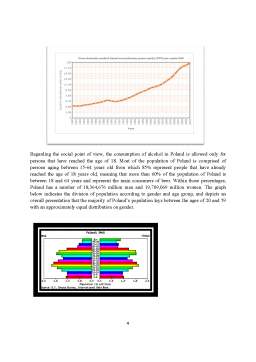Cuprins
- 1. Description of the company: 1
- 2. The internationalization process of the company 2
- 3. Strategic management elements: 3
- 3.1. Mission 3
- 3.2. Analysis of external environment 3
- 3.2.1. Competitive advantages 5
- 3.3. Analysis of internal environment 8
- 3.4. Goals, objectives and plan formulation 8
- 3.5. Implementation of the plan 9
- 3.6. Methods of evaluation and control for your company 10
- 3.6.1. Monitoring ad campaigns 10
- 3.6.2. Customer profile 11
- 3.6.3. Sales force evaluation 11
- 4. Strategic orientation 12
- 5. Type of strategy 12
- 6. The organizing structure of the company 14
- 7. Production strategy 15
- 8. Marketing strategy: 15
- 8.1. Product 16
- 8.2. Price 17
- 8.3. Place 17
- 8.4. Promotion 18
- 9. The cultural impact on the company’s activity 18
- 10. Conclusions 18
Extras din proiect
1. Description of the company:
Timisoreana is a Romanian beer brand, traditional from the Timisoara Brewery. Timisoreana is one of the oldest Romanian beer brands, it started being produced 300 years ago , being officially attested since 1718 in a petitioner act issued by Timisoara’s local authorities. In 2001 it was bought by Ursus Breweries , becoming a part of international SUBMiller. In 2002 it was re - launched at national level and was positioned mainstream. From 2006 the packaging, the bottle, the labels, and the alcohol concentration have been modified according to the increase of the brand’s indicators.
In what concerns the field of activity, the Romanian beer market has a variety of products offered by the players on the market. Romania is among the top European Beer consuming countries, on the 9th position. The first 3 positions are occupied by the Czech Republic (156,9l/person), Ireland(131,1 l) and Germany (115,8). Romanians consume approximately 75 liters of beer per person per year, beer representing 39% of the consumed alcohol.
In 2011, the sold volume of beer settled at approximately 17 million Hl. The level decreased with 16% compared to the peak from 2008 and it is similar to 2006. Though, in 2012 it managed to stabilize. The increasing trend of the PET percentage in the total has continued this type of packaging over passed 50% of the sold volume. If considering a top for the sales of PET beer bottles, Romania occupies the first position. Considering the quality/price report, Ursus and Timisoareana are the best on the Romanian Market. Romanians tend to buy more low quality beer this being the biggest threat for the following years. This is explained by the fact that the income has significantly decreased after 2008 and people pay more attention to the way they are spending their money.
Approximately 98% of the local market is covered by the pale ale (blonde beer) but in the following years other types of beer, dark and flavored, are expected to have an increasing demand, reaching 10% of the market.
Since we are considering a multinational company, the Polish market is an important variable that needs to be taken into consideration. Poland constitutes a market of over of 38 million people located in the heart of central Europe, sharing borders with both “new” EU and “old” EU-15 countries and markets to the East including Ukraine, Belarus and Russia (Kaliningrad oblast).
Poland's integration into the European Union (EU) has been a gradual but steady process.Adoption of EU legislation allowed Poland to reform the way in which its economy is regulated and restrict government intervention in the private sector. Changes in areas such as financial markets, company and competition law, accounting, and intellectual property rights have created a better environment for business and have contributed to economic growth. Polish people have lower beer consumption that Romanians, meaning 69.1 l/ person, and 56% of the alcohol consumption. Approximately 75% of the beers sales in Poland take place in supermarkets and other retail outlets.
Regarding the volume of sales in every part of the triad, we need to make a comparison between the Romanian market and the Polish market to truly understand all the characteristics of the multinational enterprise.
Timisoreana is the best sold beer brand in Romania, having a market share of 11.3% in volume and 2.2. million hectoliters on annual basis. One of the advantages that support these nice figures, besides the people’s taste, is the fact that Timisoreana is part of Ursur Breweries which is the leader on the Romanian market, with a share of 31%. Timisoareana also has the title of the beer with the fastest increase on the mainstream segment.
In 2011, Timisoreana won the battle in the beer industry, and managed to beat its main competitors Bergenbier and Golden Brau. According to a Gfk study, 98.5 % of the beer consumed in Romania is produced in the country, the rest being imported. Timisoreana is the most popular among Romanians. In 2010 Timisoreana had an increase of 13074500 lei.
The volume of the imported beer on the Polish beer market is limited (only 250 000 hectoliters were imported in 2009). Exports of polish beer grew substantially in recent years, from 1.0 hectoliters in 2007 to 1.5 hectoliters in 2009. In 2009 beer imports accounted for approximately 0.6% of the total beer market.
Bibliografie
Alfred, D (1966) Strategy and Structure. Garden City: Anchor Books
Ambos, B and Schlegelmilch, B. (2010) The New Role of Regional Management. Basingstoke: Palgrave Macmillan.
Retrieved December 2012 From: http://www.scotlandfoodanddrink.org/site/guide_doc/How-do-I-monitor-my-marketing-campaign-2.pdf
Rugman, A. and Collinson, S. (2012) International busines. Essex: Pearson Education.
Retrieved December 2012 From: http://www.ziare.com/magazin/inedit/romania-in-topul-statelor-europene-cele-mai-mari-consumatoare-de-bere-vezi-clasamentul-1121943
Preview document
Conținut arhivă zip
- Introduction of Timisoreana on The Polish Market.doc

























